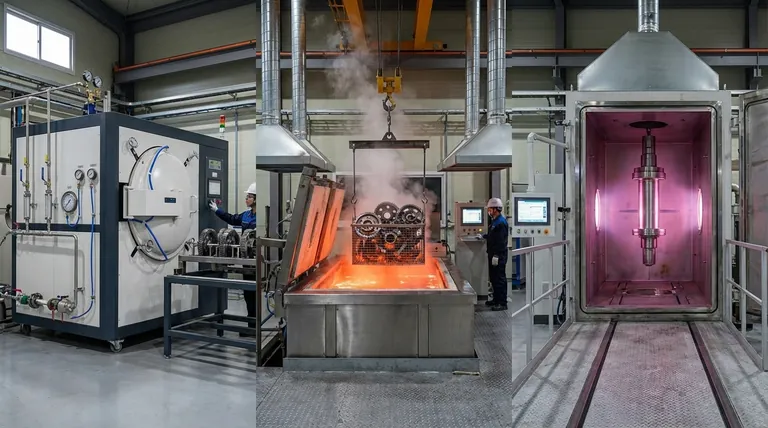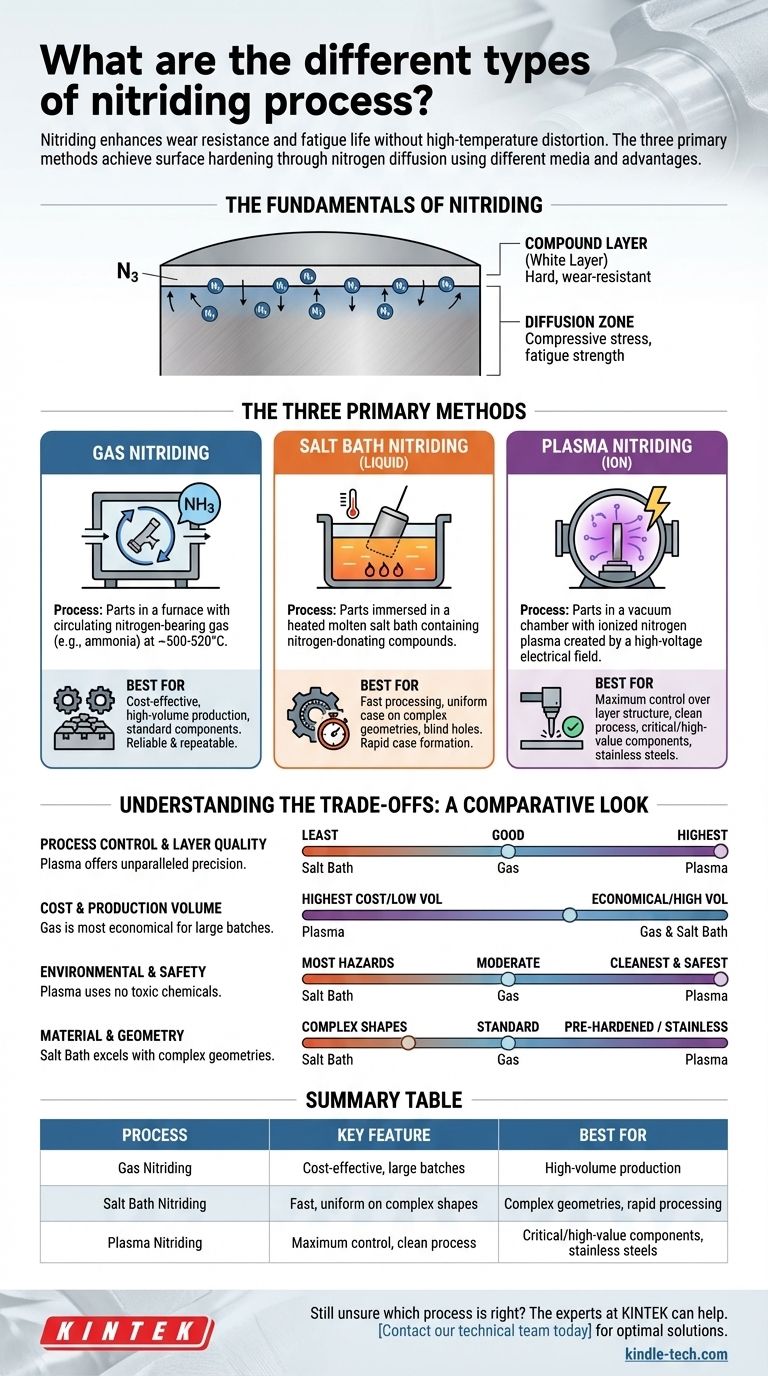표면 경화 방법을 선택할 때, 질화는 변형을 유발하는 고온을 필요로 하지 않으면서 내마모성과 피로 수명을 향상시키는 능력으로 두드러집니다. 질화의 주요 유형은 가스, 염욕(액체), 플라즈마(이온) 질화입니다. 세 가지 공정 모두 질소를 강철 또는 합금 부품에 확산시켜 표면 경화를 달성하지만, 근본적으로 다른 매체를 사용하며 제어, 비용 및 응용 분야에서 뚜렷한 이점을 제공합니다.
가스, 염욕, 플라즈마 질화 중에서 선택하는 것은 어느 것이 "최고"인지의 문제가 아니라, 특정 엔지니어링 요구 사항에 대해 야금학적 제어, 생산량 및 비용의 최적 균형을 제공하는 공정을 선택하는 문제입니다.

질화의 기본 원리
공정을 선택하려면 먼저 목표를 이해해야 합니다. 질화는 단일한 것이 아닙니다. 이는 뚜렷한 구역을 가진 구조화된 표면을 생성합니다.
질화란 무엇입니까?
질화는 질소 원자를 금속 표면으로 확산시키는 열화학적 표면 경화 공정입니다. 이는 모재 및 합금 원소와 단단한 질화물 화합물을 생성하여 표면 경도를 극적으로 증가시킵니다.
목표: 화합물층 및 확산층
이 공정은 두 가지 주요 층을 형성합니다. 가장 바깥쪽의 화합물층("백색층"이라고도 함)은 매우 단단하며 뛰어난 내마모성과 내부식성을 제공합니다.
그 아래의 확산층은 질소 원자가 재료의 결정 격자로 침투하여 압축 응력을 생성하는 곳입니다. 이 구역은 피로 강도의 상당한 증가를 담당합니다.
세 가지 주요 질화 방법
각 방법은 질소를 부품 표면에 전달하기 위해 다른 매체를 사용하며, 이는 공정 특성에 직접적인 영향을 미칩니다.
가스 질화
이것은 가장 전통적이고 널리 사용되는 방법입니다. 부품을 순환하는 질소 함유 가스, 가장 일반적으로 암모니아(NH3) 분위기 속의로에 넣습니다.
일반적인 온도인 500-520°C에서 암모니아는 강철 표면에서 해리되어 부품 내부로 확산되는 활성 질소 원자를 방출합니다.
가스 질화의 주요 이점은 대량의 부품을 처리하는 데 비용 효율적이라는 것입니다. 이는 잘 이해되고 매우 반복 가능한 공정입니다.
염욕 질화 (액체 질화)
이 방법은 질소 공여 화합물을 포함하는 가열된 용융 염욕에 부품을 담그는 것을 포함합니다. 이들은 일반적으로 시안화물-시안산염 기반 염입니다.
이 공정은 종종 Tenifer 또는 Melonite와 같은 상표명으로 불립니다. 가스 질화보다 빠르며 복잡한 형상에 균일한 경화층을 형성하는 데 탁월합니다.
많은 염욕 공정은 실제로 질화탄화(nitrocarburizing)인데, 이는 향상된 특성을 위해 표면에 질소와 소량의 탄소를 모두 주입하기 때문입니다.
플라즈마 질화 (이온 질화)
플라즈마 질화는 가장 기술적으로 진보된 방법입니다. 부품을 진공 챔버에 넣고, 그 다음 질소를 주로 하는 정밀한 가스 혼합물로 채웁니다.
고전압 전기장이 인가되어 부품 주위에 이온화된 가스 또는 플라즈마가 생성됩니다. 이 질소 이온은 가속되어 부품 표면을 폭격하고, 가열하며 확산을 위한 활성 질소를 제공합니다.
이 방법은 질화층의 구조와 조성에 대한 탁월한 제어를 제공합니다.
상충 관계 이해: 비교 분석
단일 공정이 모든 상황에서 우수한 것은 아닙니다. 올바른 선택은 성능 요구 사항과 실제 제약 조건의 균형에 달려 있습니다.
공정 제어 및 층 품질
플라즈마 질화는 가장 높은 수준의 제어를 제공합니다. 가스 혼합물, 압력 및 전기 매개변수를 정밀하게 관리함으로써 화합물층의 성장을 선택적으로 제어할 수 있습니다. 이는 취성 있는 백색층이 바람직하지 않은 응용 분야에서 중요합니다.
가스 질화는 경화 깊이에 대해 양호한 제어를 제공하지만, 플라즈마에 비해 화합물층의 상 조성에 대한 제어는 덜합니다. 염욕 질화는 공정 제어가 가장 적습니다.
비용 및 생산량
가스 질화는 대량 생산에 가장 경제적입니다. 장비와 소모품이 비교적 저렴하며, 대형로에서 한 번에 많은 부품을 처리할 수 있습니다.
염욕 질화 또한 대량 작업에 적합합니다. 플라즈마 질화는 초기 장비 비용이 가장 높으며 일반적으로 소규모 배치 또는 개별 고가 부품에 더 적합합니다.
환경 및 안전 영향
플라즈마 질화는 가장 깨끗하고 안전한 공정입니다. 독성 화학 물질을 사용하지 않으며 유해 부산물을 생성하지 않습니다.
가스 질화는 다량의 암모니아를 사용하는데, 이는 유독하고 인화성 가스이므로 신중한 취급이 필요합니다. 염욕 질화는 고온의 독성 시안화물 염 사용과 그에 따른 폐기 문제로 인해 가장 심각한 위험을 초래합니다.
재료 및 형상 고려 사항
플라즈마의 낮은 공정 온도는 재료의 템퍼링 온도보다 낮은 온도에서 질화할 수 있어 코어 강도를 보존하므로 예비 경화된 강철에 이상적입니다. 또한 스테인리스강에 대해서도 독특하게 효과적입니다.
염욕 질화는 액체가 완전하고 균일한 표면 접촉을 보장하므로 매우 복잡한 형상, 맹구멍 및 작은 오리피스가 있는 부품을 처리하는 데 탁월합니다.
응용 분야에 적합한 공정 선택
최종 결정은 프로젝트의 가장 중요한 요소에 따라 안내되어야 합니다.
- 대량 부품의 비용 효율적인 처리에 중점을 둔 경우: 가스 질화는 업계 표준이며 특성의 안정적인 균형을 제공합니다.
- 중요 부품에 대한 최대 제어 및 성능에 중점을 둔 경우: 플라즈마 질화는 경화 구조에 대한 탁월한 정밀도를 제공하므로 고가 응용 분야에 이상적입니다.
- 속도 및 복잡한 형상 부품 처리에 중점을 둔 경우: 염욕 질화는 빠른 경화층 형성을 제공하지만 유해 물질에 대한 신중한 관리가 필요합니다.
이러한 핵심 차이점을 이해함으로써 엔지니어링 목표 및 운영 능력에 완벽하게 부합하는 질화 공정을 선택할 수 있습니다.
요약표:
| 공정 | 주요 특징 | 최적 용도 |
|---|---|---|
| 가스 질화 | 비용 효율적, 대량 배치 | 대량 생산, 표준 부품 |
| 염욕 질화 | 빠름, 복잡한 형상에 균일함 | 복잡한 형상, 빠른 처리 |
| 플라즈마 질화 | 최대 제어, 깨끗한 공정 | 중요/고가 부품, 스테인리스강 |
귀하의 부품에 적합한 질화 공정이 여전히 확실하지 않습니까? KINTEK의 전문가들이 도와드리겠습니다. 당사는 표면 경화 공정을 포함하여 재료 테스트 및 분석을 위한 실험실 장비 및 소모품 공급을 전문으로 합니다. 당사는 재료, 형상 및 성능에 대한 특정 요구 사항을 분석하여 최적의 솔루션을 권장할 수 있도록 도와드릴 수 있습니다. 귀하의 프로젝트에 대해 논의하고 응용 분야에 완벽한 표면 특성을 얻을 수 있도록 지금 바로 기술팀에 문의하십시오.
시각적 가이드




















